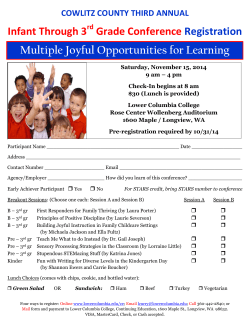
GCSE English Literature Specification A
GCSE English Literature Specification A Written Paper 70% (1 hour 45 mins) Section A One question based on post – 1914 prose. There will be a choice of questions (30% of marks) Section B One question based on pre – and post – 1914 poetry from the Anthology. There will be a choice of 3 questions (40% of marks). 12 key poems. GCSE English Literature Specification A Coursework 30% Three tasks Drama (pre – 1914) (Shakespeare*) 10% *Prose (pre 1914)* Drama (post 1914) 10% 10% * indicates a possible ‘cross – over’ response to GCSE English Specification A. One of these may be an oral response if it is done as a cross - over piece. English Literature Examination (1) Section A: Post 1914 prose The following Assessment Objectives are tested in this section: 3.1 respond to texts critically, sensitively and in detail, using textual evidence as appropriate 3.2 explore how language, structure and forms contribute to the meaning of texts, considering different approaches to texts and alternative interpretations 3.3 explore relationships and comparisons within and between texts, selecting and evaluating relevant material. Section A: Post 1914 Prose Assessment Objectives 3.1 and 3.2 are tested in each question. Assessment Objective 3.3, however, is not always tested, except on Questions 1 – 3, on the AQA Anthology short stories. In these questions, candidates will always be asked to compare two short stories (must do at least 5 stories to ‘have a go’). Questions styles are differentiated between Foundation and Higher Tier. Foundation Tier questions will always have prompts to support the candidates’ writing, whereas in the Higher Tier paper only one of the two questions will have prompts, to enable candidates to be freer in their approach. As the Sample Papers show, question setters will sometimes set a passage from a prose text as the stimulus for response. Section B: Pre and Post 1914 poetry from the Anthology The following Assessment Objectives are tested in this section: 3.1 respond to texts critically, sensitively and in detail, using textual evidence as appropriate 3.2 explore how language, structure and forms contribute to the meaning of texts, considering different approaches to texts and alternative interpretations 3.3 explore relationships and comparisons within and between selecting and evaluating relevant material. texts, All the Objectives are tested in each question in this section. No balance necessary 2 poets, 4 poems each and 4 pre 1914 poems = 12 key poems, some are cross – over SO 2 cross – over + 1 (H) + pre 1914 = 6 poems. Other 6 for revision skills Comparing Poems In Section B of the English Literature examination paper candidates are required to compare poems by a pair of poets in the AQA Anthology. The pairs to choose from are Seamus Heaney and Gillian Clarke, of Carol Ann Duffy and Simon Armitage. They are also required, however, to compare these poems with at least 2 of the poems in the pre – 1914 bank of poems provided in the Anthology. Section B: Pre and Post 1914 poetry from the Anthology (2) To give candidates maximum flexibility in examination choices they should study all eight by each of their chosen poets. There are some suggestions, however, about which poems might be studied most closely for each pair and tier, in order to make the widest possible range of comparisons. Revised Key Poems (1) Heaney and Clarke Foundation Heaney Mid – Term Break Follower Digging Death of a Naturalist Clarke Baby Sitting On the Train Catrin The Field Mouse Pre-1914 The Eagle Song of the Old Mother On My First Sonne I love to see the summer Higher At a Potato Digging Storm on the Island Digging Death of a Naturalist Cold Knap Lake A Difficult Birth Catrin The Field Mouse Patrolling Barnegat The Affliction of Margaret On My First Sonne I love to see the summer Revised Key Poems Duffy and Armitage Foundation Duffy Stealing Salome Education for Leisure Havisham Armitage My father thought it November Kid The Hitcher Pre-1914 The Man He Killed Song of the old mother On My First Sonne The Laboratory Higher Anne Hathaway Before You Were Mine Havisham Education for Leisure Mother, any distance Homecoming Kid The Hitcher Sonnet 130 My Last Duchess On My First Sonne The Laboratory Tackling English Literature Poetry English Literature poetry counts for 40% of the total English Literature mark. Candidates have one hour to complete the questionnaire. Candidates should refer to four poems in their answer: one each from the paired, named poets and two from he pre – 1914 Bank. Teachers should aim to teach from a variety of poems, thematically. English Literature These are extracts from the draft Mark Scheme at the three main notional grade boundaries. Answers are likely to include: F grade: selection of appropriate material from 2 or more poems simple comments on details of subject matter some awareness of writer’s purposes/use of words some linkage between similarity or difference. C grade: treatment of at least 3 poems, including pre – and post 1914 focus on task explained/sustained response to details of feelings/attitudes/ideas identification/explanation of writer’s language and devices to present or affect structured/sustained comparison/contrast A grade: treatment of at least 4 poems, including 2 pre – 1914 and 2 post – 1914 exploration/development of terms/implications of task sensitive/critical response to situation/character/meaning developed/analytical comment on/response to writer’s intended/implied purposes evaluative comparison/contrast English Literature Having gone through the same process of reading the poems as for the Poems From Different Cultures and Traditions, the frame they require in order to produce notes to ‘hit’ the requisite Assessment Objectives is slightly different: What is the poem about? What are the poet’s feelings/attitudes/ideas English Literature How does the poet use the structure of the poem and any poetic devices? What similarities of differences can you see with other poems in the selection? Was the poet successful in his/her purpose and what is you final opinion?
© Copyright 2025












